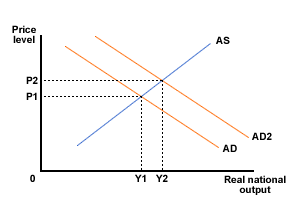Policies to reduce Demand Deficient unemployment
Syllabus: Evaluate government policies to deal with the different types of unemployment.
If unemployment is cyclical or demand-deficient, then the best
policy to get rid of it will be to boost the level of aggregate demand
(Standard Keynesian argument - contested by Neoclassicals).
Sounds easy, but how can the government achieve this? They use expansionary monetary policy and/or fiscal policy the aim is to shift AD to the right remember.
This could mean:
- Cutting interest rates - this should encourage consumption (Credit) and investment (Borrowing) and, therefore, boost aggregate demand (Monetary Policy)
- Increasing the Money Supply - More money implies more expanditure (Monetary Policy)
-
Increasing government expenditure - government spending is a
crucial component of aggregate demand and so increasing spending,
perhaps on education, health or roads, will help boost aggregate demand
and reduce unemployment. (Fiscal Policy)
-
Cutting taxes - government could cut direct and/or indirect
taxes; both of these actions should encourage consumption . Higher
consumption should mean more employees are required to make the
additional goods and services demanded. A reduction intaxes on profits
might also encourage investment. (Fiscal Policy)
These expansionary fiscal or monetary policies should increase aggregate demand and shift the aggregate demand curve to the right as in figure 1 below.
 Put in Keynesian LRAS instead/as well
Put in Keynesian LRAS instead/as well
Figure 1 Expansionary fiscal/monetary policy
This solution appears to be quite simple, but in macroeconomics
things are rarely as simple as they first appear! As we already know,
policy conflicts can arise, especially the possible effects on
inflation of higher aggregate demand.
So, a mixture of monetary policy, fiscal policy and supply-side policies (see later but basically shifting Aggregate Supply to the right) would normally be used. Governments hope that supply-side policies will boost the capacity of the economy and enable higher aggregate demand, but without the associated inflationary pressures.
In the long run, if there is no shortage of aggregate demand, the
cause of the unemployment is likely to lie with supply-side problems,
such as geographic and occupational immobility of labour, lack of
appropriate skills and training or a lack of information (Structural
Unemployment).
This type of unemployment can be tackled by application of appropriate supply-side policies, as previously identified in Section 2.6.
Past paper Essay
May 2010 TZ2
2. (a) Explain why a country may wish to reduce its unemployment rate. [10 marks]
(b) Evaluate the likely effects on the economy of relying on demand-side policies to reduce the unemployment rate. [15 marks]